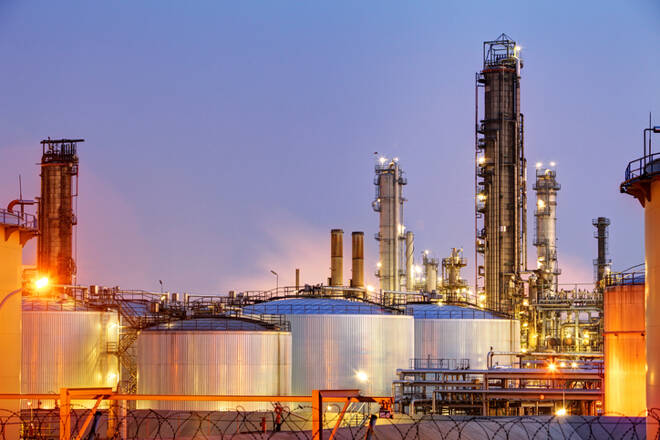Advertisement
Advertisement
Natural Gas Price Fundamental Daily Forecast – EIA Reading North of 110 Will Be Viewed as Bearish
By:
Regarding the EIA report, a number higher than 110 will be viewed as bearish by traders, while a build under 100 could trigger a bullish reaction.
Natural gas futures are inching higher for a third consecutive session on Thursday as traders prepare for the release of the latest government weekly storage data later today. After plunging to a multi-month low on Monday, the market has consolidated, suggesting a support base may be forming. Natural Gas Intelligence (NGI) said on Wednesday, “… much of the fundamental supply/demand backdrop became increasingly supportive of prices.”
At 10:01 GMT, July natural gas futures are trading $1.824, up $0.003 or +0.16%.
Three other factors also contributed to the higher prices on Wednesday: Higher spot prices, added heat in the weather models and higher feed gas volumes being delivered to U.S. liquefied natural gas (LNG) terminals, according to NGI.
“LNG is moving up off the lows, and that, along with some near-term heat, gave daily cash prices a boost this morning (Wednesday), igniting the rally,” Bespoke Weather Services said.
Traders also said that gains may have been limited by demand risks associated with Tropical Storm Cristobal’s arrival along the central Gulf Coast this weekend into early next week. Genscape, however, noted that the potential impacts to Gulf Coast production cannot be deemphasized, according to Genscape, Inc.
At the start of hurricane season on June 1, natural gas traders should note that hurricanes that hit Florida tend to drive prices down because of lost demand, while hurricanes that hit Texas or Louisiana tend to drive prices higher because of potential damage to production facilities.
US Energy Information Administration Weekly Storage Report
The EIA will report on weekly storage at 14:30 GMT. The report is expected to show a build of about 110.
Bespoke is estimating a build of 106 Bcf in the report, which falls a few Bcf below consensus. A Wall Street Journal poll of 12 analysts, brokers and traders produced injection estimates ranging from 96 Bcf to 122 Bcf, with an average of 110 Bcf. A Bloomberg survey had a tighter range of forecasts with a median of 111 Bcf, while a Reuters survey landed at a 110 Bcf injection. NGI estimated a 104 Bcf build.
Last year, the EIA recorded a 118 Bcf increase in storage for the similar week, while the five-year average build stands at 103 Bcf.
Short-Term Weather Outlook
According to NatGasWeather for June 4 – June 10, “Texas, the South, and Southeast will be very warm to hot with highs of 80s to low 90s, although cooling next week as Tropical Storm Cristobal makes landfall out of the Gulf of Mexico. Cooler air with showers will push into the Northwest while California and the Southwest remain hot with temperatures of 90s and 100s. The Midwest and Northeast will be warm with 70s and 80s, including Chicago to NYC, while locally near 90F near D.C. Next week favors a weather system with cooling over the West, heavy showers over East Texas and the South, and very warm Great Lakes, Ohio Valley and East.
Daily Forecast
Regarding the EIA report, a number higher than 110 will be viewed as bearish by traders, while a build under 100 could trigger a bullish reaction.
Shortly after the report, traders will shift their focus to LNG feed gas demand and the weather.
According to EBW Analytics Group, plummeting LNG feed gas demand is likely to be one of the largest near-term factors driving gas prices. Although it is unclear how quickly the dynamic will play out, continued feed gas demand below 4.0 Bcf/d may spur faster revisions.
“It continues to appear that the market may have underestimated the extent of global demand weakness, likely yielding downward pressure.”
For a look at all of today’s economic events, check out our economic calendar.
About the Author
James Hyerczykauthor
James Hyerczyk is a U.S. based seasoned technical analyst and educator with over 40 years of experience in market analysis and trading, specializing in chart patterns and price movement. He is the author of two books on technical analysis and has a background in both futures and stock markets.
Did you find this article useful?
Latest news and analysis
Advertisement
